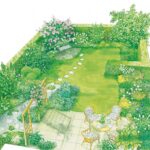Are you looking to make the most of your small garden space? Incorporating simple garden design ideas for small gardens can help you create a beautiful and functional outdoor area, no matter the size.
In this article, we will explore the benefits of simple garden design for small spaces and provide tips and ideas for maximizing space, choosing the right plants, creating the illusion of space, incorporating functional elements, adding lighting, utilizing containers and raised beds, and designing pathways and walkways.
When it comes to small gardens, simplicity is key. By embracing a minimalist approach to design, you can create an inviting and stylish outdoor space that maximizes every inch of your garden.
From vertical elements to low-maintenance plants to clever lighting solutions, there are many ways to make the most of a compact garden area. Whether you’re dealing with a tiny urban patio or a small backyard, these simple garden design ideas will help transform your space into a beautiful oasis.
In the following sections, we will delve into specific strategies for designing small gardens that are both practical and visually appealing. By implementing these simple yet effective ideas into your garden design, you can create a tranquil and enjoyable outdoor retreat that suits your lifestyle and complements your home’s aesthetic. Let’s explore how simple garden design can unlock the potential of small spaces.
Maximizing Space
When designing a small garden, it’s important to maximize the use of vertical space in order to create the illusion of a larger area. Utilizing vertical elements not only adds visual interest to the garden but also provides more room for planting and functional features. There are several simple garden design ideas for small gardens that can help make the most of vertical space.
Vertical Planters and Trellises
One effective way to maximize space in a small garden is by using vertical planters and trellises. These structures can be mounted on walls or fences, allowing you to grow a variety of plants without taking up precious ground space. Consider planting trailing vines, compact herbs, or even small vegetables in these vertical planters to add greenery without sacrificing space.
Hanging Gardens
Hanging gardens are another excellent option for small garden design. By hanging plants in baskets or containers from overhead structures or pergolas, you can add depth and dimension to your garden without cluttering the ground. This approach also allows you to grow a mix of flowers, herbs, and even strawberries in an eye-catching display.
Vertical Garden Structures
For a more permanent solution, consider installing a vertical garden structure such as a living wall or trellis system. These features not only provide additional planting space but also serve as decorative focal points in the garden. Vertical structures can be custom-designed to fit your specific needs and aesthetic preferences, making them a versatile and efficient choice for small garden spaces.
By incorporating these simple garden design ideas for small gardens, you can create an inviting and visually appealing outdoor oasis that maximizes every inch of available space. Embracing vertical elements will not only help you make the most of your small garden but also allow you to cultivate a lush and vibrant environment that feels much larger than its actual footprint.
Choosing the Right Plants
When it comes to simple garden design ideas for small gardens, choosing the right plants is crucial. Low-maintenance and space-saving options can help maximize the potential of a small garden space while still adding beauty and greenery. Here are some plant options to consider for your small garden:
- Vertical plants: Utilize climbing plants such as ivy, jasmine, or clematis to add height without taking up valuable ground space.
- Compact shrubs: Opt for dwarf varieties of shrubs and bushes that won’t overwhelm the limited garden area.
- Herbs and vegetables: Consider growing herbs and vegetables in containers or raised beds to provide a functional yet space-saving element to your garden.
In addition to choosing the right plants, it’s important to ensure that they are low-maintenance. Selecting plants that require minimal care will make it easier to upkeep your small garden without feeling overwhelmed by maintenance tasks. Look for species that are well-suited to your specific climate and soil conditions, as these will generally require less attention.
Finally, incorporating a variety of plant types can add visual interest and depth to a small garden. Mix in flowering plants, ornamental grasses, and foliage with different colors and textures to create a dynamic and inviting green space. With the right plant selection, you can transform your small garden into a lush and vibrant oasis, regardless of its size.
Creating the Illusion of Space
Designing a small garden to feel more spacious can be achieved through various techniques. One effective method is by utilizing mirrors strategically placed on walls or fences to create the illusion of depth and space. Mirrors not only reflect light but also make the garden appear larger than it actually is. Another way to create the feeling of openness is by using lighter colors for paint, furniture, and decor. Light colors tend to make spaces look bigger and brighter.
In addition, incorporating pathways and walkways can give the impression of a larger garden. By creating winding paths or using diagonal lines, you can visually expand the space and add interest to your garden design. It’s important to consider both straight and curved pathways as they offer different visual effects – straight paths can make a garden feel longer while curved paths add movement and intrigue.
Furthermore, using multi-functional furniture such as benches with built-in storage or tables that fold away when not in use can help maximize space in a small garden. Additionally, opting for slimline seating options like stackable chairs or benches with open slats can provide functional seating without overwhelming the limited space.
| Technique | Description |
|---|---|
| Use of Mirrors | Strategically placing mirrors on walls or fences creates an illusion of depth and space in small gardens. |
| Light Colors | Incorporating lighter colors for paint, furniture, and decor makes small gardens look bigger and brighter. |
| Pathways and Walkways | Winding paths or diagonal lines visually expand the space and add interest to small garden designs. |
Incorporating Functional Elements
When it comes to designing a small garden, it’s important to make the most of every inch of space. One way to achieve this is by incorporating functional elements such as seating, storage, and dining areas. These elements not only add practicality to your small garden but can also enhance its overall aesthetic appeal.
Seating
In a small garden, seating is an essential element that provides a place for relaxation and enjoyment of the outdoor space. When choosing seating for a small garden, consider options that are compact and multi-functional. Folding chairs, benches with hidden storage, or built-in seating can maximize space while still providing comfort and functionality.
Storage
Incorporating storage solutions in a small garden is vital for keeping the space clutter-free and organized. Utilize vertical space with shelving units or wall-mounted cabinets to store gardening tools, pots, and other accessories. Additionally, consider using multi-purpose furniture with built-in storage compartments to maximize space efficiency.
Dining Areas
Even in a small garden, creating a designated dining area can elevate the overall experience of outdoor entertaining. Opt for folding tables or bistro sets that can be easily tucked away when not in use. Consider using versatile furniture pieces that can serve multiple functions, such as a dining table that doubles as a potting bench.
By strategically incorporating these functional elements into your small garden design, you can create a practical and inviting outdoor space that maximizes every inch of your available area. Whether it’s creating a cozy seating nook, organizing gardening tools in clever storage solutions, or enjoying al fresco dining in a compact dining area, simple garden design ideas for small gardens can seamlessly blend form and function.
Lighting for Small Gardens
When it comes to designing a small garden, lighting plays a crucial role in creating an inviting and enjoyable outdoor space, especially in the evenings. The right lighting can not only enhance the aesthetic appeal of the garden but also extend its use after sunset. Here are some illuminating design ideas for small gardens that will help create a cozy and enchanting atmosphere.
One simple yet effective idea for lighting small gardens is to incorporate solar-powered or low-voltage LED lights. These options are energy-efficient, easy to install, and can be placed strategically to illuminate pathways, plants, and architectural features. Additionally, string lights or fairy lights can be used to add a whimsical and magical ambiance to the garden, especially when draped over trees or shrubs.
Another way to illuminate a small garden is by using uplighting or downlighting techniques. Uplighting involves placing light fixtures at ground level and directing the light upwards towards trees, statues, or other focal points to create dramatic silhouettes and shadows. On the other hand, downlighting fixtures can be mounted on elevated surfaces such as pergolas or fences to cast a gentle and subtle glow over specific areas of the garden.
Lastly, consider incorporating candles or lanterns into your small garden design. These portable light sources not only add a warm and intimate feel but also provide flexibility in their placement. Whether clustered on tabletops, hung from branches, or scattered around seating areas, candles and lanterns bring a touch of romance and charm to any small garden space.
| Illuminating Design Ideas | Examples |
|---|---|
| Solar-powered or low-voltage LED lights | Pathway lighting, accent lighting for plants |
| String lights or fairy lights | Drapped over trees or shrubs for a magical effect |
| Uplighting or downlighting techniques | Dramatic silhouettes through uplighting and gentle glow through downlighting |
| Candles or lanterns | Provide warmth and intimacy in various placements throughout the garden |
Utilizing Containers and Raised Beds
When it comes to simple garden design ideas for small gardens, utilizing containers and raised beds can be incredibly effective. These solutions not only help maximize space but also provide opportunities for creativity and flexibility in your garden design.
Containers are a versatile option for small gardens, allowing you to plant flowers, herbs, and even vegetables without needing a large plot of land. They can be placed on patios, balconies, or even hung from railings to make the most of vertical space. When choosing containers, opt for different sizes and shapes to add visual interest to your garden while also accommodating the needs of various plants.
Raised beds are another excellent solution for small garden spaces. Not only do they provide an organized and visually appealing way to plant your favorite flowers or vegetables, but they also offer better soil drainage and prevent soil compaction. This is especially beneficial in small gardens where space is limited but the desire for lush greenery is not.
In addition to their practical benefits, both containers and raised beds can add depth and dimension to your garden design, creating visual appeal through varying heights and textures. Whether you have a tiny urban balcony or a small backyard, incorporating these simple solutions can transform your space into a flourishing oasis.
Designing Pathways and Walkways
When it comes to designing pathways and walkways in a small garden space, it’s essential to create flow and cohesion while maximizing every inch of available space. Here are some simple ideas for creating pathways and walkways in small gardens:
- Utilize stepping stones or gravel paths to create a sense of movement and easy navigation through the garden.
- Consider using curved pathways instead of straight lines to add visual interest and create the illusion of more space.
- Incorporate different materials such as brick, wood, or pavers to delineate different areas within the garden while adding texture and style.
In addition, accessorizing your pathways with strategically placed planters, garden ornaments, or lighting fixtures can enhance the overall visual appeal of your small garden. Remember to keep maintenance in mind when choosing pathway materials and designs for a low-maintenance yet beautiful small garden space that you can enjoy year-round.
Overall, creating well-designed pathways and walkways is key to enhancing the functionality and aesthetic of small gardens. These simple design ideas can help you make the most out of limited space while adding charm and character to your outdoor oasis.
Conclusion
In conclusion, simple garden design ideas for small gardens offer numerous benefits and opportunities to create beautiful and functional outdoor spaces. By embracing the principles of maximizing space, choosing the right plants, creating the illusion of space, incorporating functional elements, utilizing lighting, containers, raised beds, pathways and walkways, homeowners can transform their compact outdoor areas into stunning retreats that are both aesthetically pleasing and practical.
The key to successful small garden design lies in the thoughtful selection of plants and elements that make the most of limited space without overwhelming it. By incorporating vertical elements such as trellises, hanging baskets or wall-mounted planters, homeowners can maximize space while adding visual interest. Likewise, choosing low-maintenance and space-saving plant varieties ensures that the garden remains manageable without sacrificing beauty.
Furthermore, by incorporating functional elements such as seating areas, storage solutions and dining spaces within a small garden design, homeowners can create inviting outdoor living spaces for relaxation and entertainment. Additionally, strategic lighting design can extend outdoor enjoyment well into the evening hours. Embracing simple design ideas is an effective way to make the most of small garden spaces while enhancing their beauty and functionality.
Frequently Asked Questions
How Do You Layout a Small Garden?
When designing a small garden layout, it’s important to maximize space by using vertical gardening techniques and organizing plants in a way that ensures each one has enough room to grow. Consider creating different levels and pathways to add visual interest and functionality to the space.
How Can I Make My Small Garden Nice?
To make your small garden nice, focus on adding elements that create a sense of charm and tranquility. This can be achieved through the use of colorful flowers, strategically placed seating areas, decorative pots or containers, and even incorporating water features or whimsical garden ornaments.
How Do You Arrange Plants in a Small Garden?
When arranging plants in a small garden, consider their mature size, growth habits, and sunlight requirements. Grouping tall plants together at the back of the garden and placing shorter ones towards the front can create depth and visual appeal. Additionally, mixing different textures and colors can add visual interest while making sure not to overcrowd the space.

Welcome to my gardening blog! I am passionate about plants and enjoy sharing my knowledge and experiences with others. In this blog, I will write about everything related to gardening, from tips on how to get started to updates on my own garden projects.





